What Is Sewage?
- Books Name
- CBSE Class 7 Science Book
- Publication
- Param Publication
- Course
- CBSE Class 7
- Subject
- Science
1.2 Sewage
Sewage is correctly the subset of wastewater, that is contaminated with faeces or urine , but is often used to mean only wastewater. Sewage is released by homes, industries, hospitals, offices etc. It also includes rainwater that has run down the street during a storm or heavy rain. Sewage has dissolved and suspended impurities. These impurities are called “contaminants”.
Wastewater constituents : Wastewater is a complex mixture containing suspended solids, organic and inorganic impurities, nutrients, saprotrophic and disease causing bacteria and other microbes. A partial list of what it may contain is given below -
(i) Organic pollutants : Human faeces, animal waste, oil, urea (urine), pesticides, herbicides,
fruit and vegetable waste, etc.
The organic matter of sewage is measured by determining its biological oxygen demand (BOD) or the chemical oxygen demand (COD).
BOD (Biological Oxygen Demand) : It is a measure of the oxygen utilised by microorganisms during oxidation of organic materials.
COD (Chemical Oxygen Demand) : It is an index of the waste (organic and inorganic) of water which can be oxidised by strong oxidising agents.
(ii) Inorganic pollutants : Nitrates, Phosphates, metals.
(iii) Nutrients : Phosphorus and Nitrogen.
Eutrophication : The excessive growth of algae and aquatic plants due to added nutrients is called eutrophication.
(iv) Pathogen and micro-pollutants : Bacteria → Which causes cholera and typhoid.
Other microbes → Which causes dysentery
1.3 Potable and Non-potable water
Potable water means water which is fit for drinking by humans and other animals. It can be consumed with low risk of immediate or long term harm. Non-potable water is that which is not safe for drinking. It may carry disease causing microbes, and high levels of dissolved salts and minerals, heavy metals and suspended solids. Drinking or using such water for cooking leads to illnesses and may even cause death.
Contaminated or non-potable water can be treated to turn it into potable or drinking water. Let us learn about simple methods of purifying water.
Wastewater Treatment Plant
- Books Name
- CBSE Class 7 Science Book
- Publication
- Param Publication
- Course
- CBSE Class 7
- Subject
- Science
1.4 Wastewater treatment plants (WWTP)
Cleaning of water is a process of removing pollutants before it enters a water body or is reused. This process of wastewater treatment is commonly known as “Sewage Treatment”. It takes place in several stages.
Treatment of wastewater involves physical, chemical, and biological processes, which remove physical, chemical and biological matter that contaminate the wastewater.
(i) Waste water is passed through bar screens where large objects like rags, sticks, cans, plastic packets, napkins are removed.
(ii) Water then goes to a grit and sand removal tank. The speed of the incoming wastewater is decreased to allow sand, grit and pebbles to settle down.
(iii) The water is then allowed to settle in a large tank which is sloped towards the middle. Solids like faeces settle at the bottom and are removed with a scraper. This is the sludge. A skimmer removes the floatable solids like oil and grease. Water so cleared is called clarified water.
The sludge is transferred to a separate tank where it is decomposed by the anaerobic bacteria. The biogas produced in the process can be used as fuel or can be used to produce electricity.
(iv) Air is pumped into the clarified water to help aerobic bacteria to grow. Bacteria consume human waste, food waste, soaps and other unwanted matter still remaining in clarified water.
After several hours, the suspended microbes settle at the bottom of the tank as activated sludge. The water is then removed from the top. The activated sludge is about 97% water. The water is removed by sand drying beds or machines. Dried sludge is used as manure, returning organic matter and nutrients to the soil.The treated water has a very low level of organic material and suspended matter. It is discharged into a sea, a river or into the ground. Nature cleans it up further. Sometimes it may be necessary to disinfect water with chemicals like chlorine and ozone before releasing it into the distribution system.
Better House Keeping Practices
- Books Name
- CBSE Class 7 Science Book
- Publication
- Param Publication
- Course
- CBSE Class 7
- Subject
- Science
1.5 BETTER HOUSE KEEPING PRACTICES
Waste generation is a natural part of human activity. But we can limit the type of waste and quantity of waste produced.
Cooking oil and fats should not be thrown down the drain. They can harden and block the pipes. In an open drain the fats clog the soil pores reducing its effectiveness in filtering water. Throw oil and fats in the dustbin.
Chemicals like paints, solvents, insecticides , motor oil, medicines may kill microbes that help to purify water. So do not throw them down the drain. Used tealeaves, solid food remains, soft toys, cotton, sanitary towels , etc. should also be thrown in the dustbin. These wastes choke the drains. They do not allow free flow of water. This hampers the degradation process.
Sanitation and Disease
- Books Name
- CBSE Class 7 Science Book
- Publication
- Param Publication
- Course
- CBSE Class 7
- Subject
- Science
1.6 SANITATION AND DISEASE
Poor sanitation and contaminated drinking water is the cause of a large number of diseases. A very large fraction of our population defecates in the open, on dry riverbeds, on railway tracks, near fields and many a time directly in water. Untreated human excreta is a health hazard. It may cause water pollution and soil pollution. Both the surface water and groundwater get polluted. Groundwater is a source of water for wells, tubewells, springs and many rivers.It becomes the most common route for water borne diseases like cholera, typhoid, polio, meningitis, hepatitis and dysentery.
Alternative Arrangement for Sewage Disposal
- Books Name
- CBSE Class 7 Science Book
- Publication
- Param Publication
- Course
- CBSE Class 7
- Subject
- Science
(a) Alternative arrangement for sewage disposal : To improve sanitation, low cost on-site sewage disposal systems are being encouraged. Examples are septic tanks, chemical toilets, combusting pits. Septic tanks are suitable for places where there is no sewerage system. For example hospitals, isolated buildings or a cluster of 4 to 5 houses.
Some organisations offer hygienic on-site human waste disposal technology. These toilets do not require scavenging. Excreta from the toilet seats flow through covered drains into a biogas plant. The biogas produced is used as a source of energy.
Sanitation at Public Places.
- Books Name
- CBSE Class 7 Science Book
- Publication
- Param Publication
- Course
- CBSE Class 7
- Subject
- Science
(b) Sanitation at public places : In our country fairs are organised periodically. A large number of people participate in them. In the same way railway stations, bus depots , airports , hospitals are very busy places. Thousands of people visit them daily. Large amount of waste is generated here. It must be disposed off properly otherwise epidemics could break out.
The government has laid down certain standards of sanitation but, unfortunately, they are not strictly enforced.
However, all of us can contribute in maintaining sanitation at public places. We should not scatter litter anywhere. If there is no dustbin in sight, we should carry the litter home and throw it in the dustbin.
(c) Vermi - processing toilet : A design of a toilet in which humans excreta is treated by earthworms has been tested in India. It has been found to be a novel, low water-use toilet for safe processing of human waste. The operation of the toilet is very simple and hygienic. The human excreta is completely converted to vermi cakes-a resource much needed for soil.
Key words
1. Aeration : Air is pumped to clarified water to help aerobic bacteria to grow.
2. Aerobic bacteria : Those bacteria which require oxygen to live are called aerobic bacteria.
3. Anaerobic bacteria : Those bacteria which can survive without oxygen are called anaerobic bacteria.
4. Biogas : It is a gaseous fuel, which is produced by the fermentation of organic matter.
5. Contaminants : The harmful substances which have dissolved and suspended as impurities are called contaminants.
6. Saintation : The proper disposal of sewage and garbage from the houses or nearby areas is callled saintation.
7. Sewage :Sewage is wastewater released by homes, industries, hospitals, offices and other sewers.
8. Sewers: The network of big and small pipes to carry wastewater to treatment plant is called sewers.
9. Sewerage : Drainage system of sewers.
10. Sludge : Solids like faeces which settle at the bottom of a large tank and are removed with a scraper are called sludge.
Water, Our Lifeline
Chapter 18: Wastewater Story
Small and big pipes that carry waste water are called sewers. All sewers together form the sewerage. Wastewater is carried from home to the point of disposal, that is, the waste water treatment plant through sewerage. After the treatment of waste water, the clean water is released into nearby water bodies.
Water , our lifeline
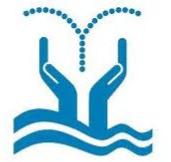
Water is our lifeline that bathes us and feeds us. In ancient cultures water represented the very essence of life. The Romans were the first to pipe water into their growing cities, especially with their aqueducts. They also realized that sewage water could cause damage to their people, and needed to be removed from large areas of people.
Water has played a role not only in the history of countries, but in religion, mythology, and art. Water in many religions cleanses the soul through holy water.
What is Sewage
Water is sewage ?
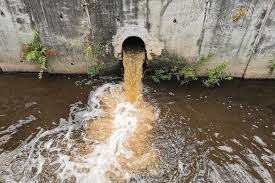
Sewage is a mixture of water (from the community’s water supply), human excreta (feces and urine), used water from bathrooms, food preparation wastes, laundry wastewater, and other waste products of normal living.
Water Freshens Up- An Eventful Journey
Water freshens up – an eventful journey
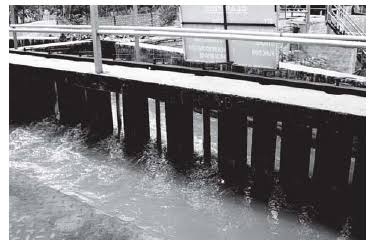
In a home or a public building generally one set of pipes brings clean water and another set of pipes takes away wastewater. Imagine that we could see through the ground. We would see a network of big and small pipes, called sewers, forming the sewerage. It is like a transport system that carries sewage from the point of being produced to the point of disposal, i.e. treatment plant. Manholes are located at every 50 m to 60 m in the sewerage, at the junction of two or more sewers and at points where there is a change in direction
Wastewater Treatment Plant
Wastewater treatment plant
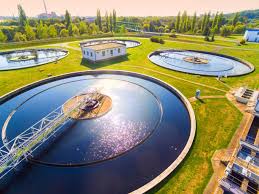
Sewage treatment (or domestic wastewater treatment, municipal wastewater treatment) is a type of wastewater treatment which aims to remove contaminants from sewage to produce an effluent that is suitable for discharge to the surrounding environment or an intended reuse application, thereby preventing water pollution from raw sewage discharges.[2] Sewage contains wastewater from households and businesses and possibly pre-treated industrial wastewater. There are a high number of sewage treatment processes to choose from.
Better House Keeping Practices
Better house keeping practices
The wastes such as solid food remain, tea leaves, sanitary towels, polythene bags, worn cotton, hair, and soft toys, among other items, should not be flushed. When these pollutants are dumped into ‘piped drains’ that convey wastewater, they clog the drains (or choke the drains) and prevent wastewater from flowing freely. These wastes also prevent the free flow of oxygen (of air) to the helpful bacteria in the drain, which aid in the decomposition of the wastes, by plugging the drains. This obstructs the natural process of wastewater treatment. Food scraps, used tea leaves, sanitary towels, polythene bags, used cotton, hair, and soft toys, among other items, should always be discarded in a trash can.
Sanitation And Disease at Public places
Sanitation and disease
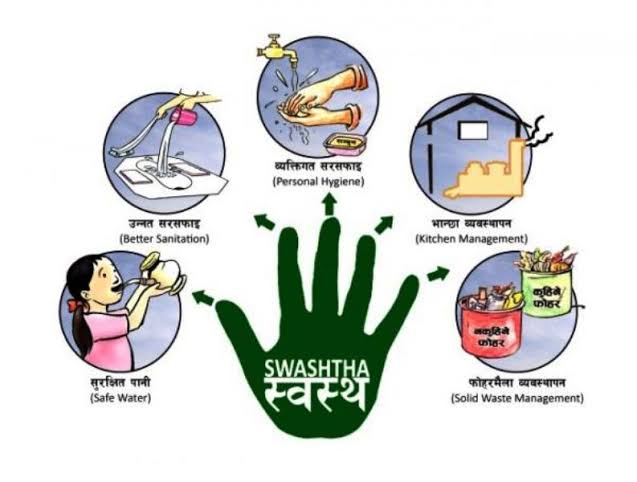
Poor sanitation is linked to transmission of diarrhoeal diseases such as cholera and dysentery, as well as typhoid, intestinal worm infections and polio. Poor exacerbates stunting and contributes to the spread of antimicrobial resistance.
Alternative arrangement for sewage disposal-
To improve sanitation low alternative arrangement for sewage disposal should be used. Such arrangement includes septic tanks, chemical toilets, compost pits etc.
Use of dustbins for throwing litters.
Use of public toilets for urination and defecation. Example- Sulabh.
Use of handkerchief or tissue paper while sneezing or coughing in order to prevent air-borne diseases.
Sanitation at public places
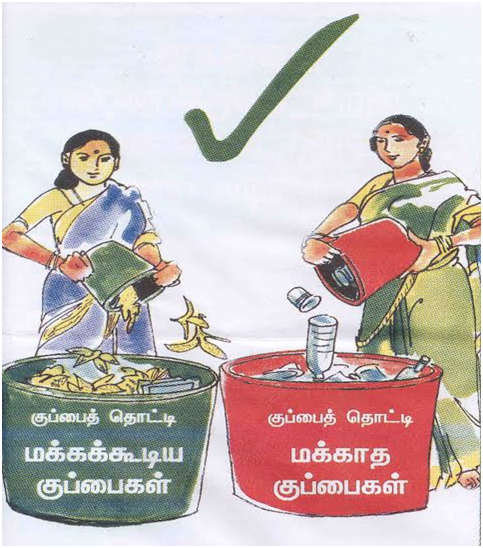
Use of public toilets for urination and defecation. Example- Sulabh.
Use of handkerchief or tissue paper while sneezing or coughing in order to prevent air-borne diseases.
Poor sanitation puts children at risk of childhood diseases and malnutrition that can impact their overall development, learning and, later in life, economic opportunities. While some parts of the world have improved access to sanitation, millions of children in poor and rural areas have been left behind
Alternative Arrangement For Sewage Disposal
Alternative arrangement for sewage disposal
To improve sanitation low alternative arrangement for sewage disposal should be used. Such arrangement includes septic tanks, chemical toilets, compost pits etc. Septic tanks and chemical toilets can be set up as an alternative for sewage disposal.
Following are 5 common methods of sewage disposal.
Treatment plants. Municipal sewage systems feed directly into sewage treatment plants. …
Sewage lagoons. Sewage lagoons are exactly what they sound like. …
On-site systems. …
Off-site systems. …
Full sewage systems.
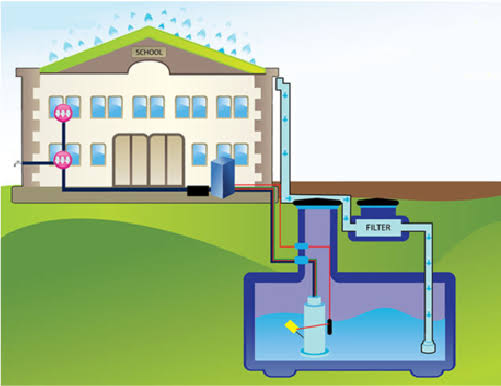

 Param Publication
Param Publication
 Grow Career Publication
Grow Career Publication
